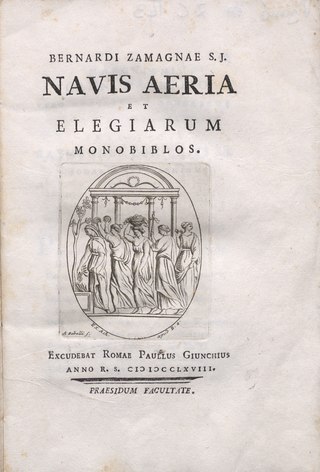
Dubrovnik, historically known as Ragusa, is a city in southern Dalmatia, Croatia, by the Adriatic Sea. It is one of the most prominent tourist destinations in the Mediterranean, a seaport and the centre of the Dubrovnik-Neretva County. Its total population is 41,562. In 1979, the city of Dubrovnik was added to the UNESCO list of World Heritage Sites in recognition of its outstanding medieval architecture and fortified old town.
The History of Dalmatia concerns the history of the area that covers eastern coast of the Adriatic Sea and its inland regions, from the 2nd century BC up to the present day. The region was populated by Illyrian tribes around 1,000 B.C, including the Delmatae, who formed a kingdom and for whom the province is named. Later it was conquered by Rome, thus becoming the province of Dalmatia, part of the Roman Empire. Dalmatia was ravaged by barbaric tribes in the beginning of the 4th century.
Francesco Maria Appendini was an Italian Latin and Italian scholar who studied Slavic languages in the Republic of Ragusa. The French invasion prevented him from returning to Italy, and he adopted Republic of Ragusa as his own country. He took it upon himself to investigate its history and antiquities.

The Republic of Ragusa was an aristocratic maritime republic centered on the city of Dubrovnik in South Dalmatia that carried that name from 1358 until 1808. It reached its commercial peak in the 15th and the 16th centuries, before being conquered by Napoleon's French Empire and formally annexed by the Napoleonic Kingdom of Italy in 1808. It had a population of about 30,000 people, of whom 5,000 lived within the city walls. Its motto was "Non bene pro toto libertas venditur auro", a Latin phrase which can be translated as "Liberty is not well sold for all the gold".

Johannes Lucius was a Dalmatian historian, whose greatest work is De regno Dalmatiae et Croatiae, which includes valuable historical sources, bibliography and six historical maps. Due to his critical approach, he is often described as the "father of Croatian historiography".

Joakim Stulić, also Joakim Stulli as styled by himself, (1730–1817) was a lexicographer from the Republic of Ragusa, the author of the biggest dictionary in the older Croatian lexicography.
Antun Sorkočević was a diplomat, writer, composer and member of Ragusan nobility. He was Medo Pucić's cousin, and a good friend of Marko Bruerović. He also held the position of Mayor of Dubrovnik during the French Empire.

Bernardo Zamagna was a Dalmatian Italian priest, poet and translator. He wrote in Latin.
Rajmund Kunić or Raimondo Cunich was a Latin and Greek humanist from Dubrovnik, Republic of Ragusa.
Bernardin Pavlović was a Franciscan writer from Dubrovnik, born in Ston. He had two works printed in Venice in 1747 which he wrote were "in Croatian". The title of the second work notes it's printed in "our worthy Croatian language" for "the use of the Croatian people", which was noticed by Vatroslav Jagić and later by John V. A. Fine as one of increasingly many examples of how the term Croatian came into use in addition to the existing more generic Illyrian (Slavic) terminology in Dalmatia.
The Serb-Catholic movement in Dubrovnik was a cultural and political movement of people from Dubrovnik who, while Catholic, declared themselves Serbs, while Dubrovnik was part of the Habsburg-ruled Kingdom of Dalmatia in the 19th and early 20th centuries. Initially spearheaded by intellectuals who espoused strong pro-Serbian sentiments, there were two prominent incarnations of the movement: an early pan-Slavic phase under Matija Ban and Medo Pucić that corresponded to the Illyrian movement, and a later, more Serbian nationalist group that was active between the 1880s and 1908, including a large number of Dubrovnik intellectuals at the time. The movement, whose adherents are known as Serb-Catholics or Catholic Serbs, largely disappeared with the creation of Yugoslavia.

Orsat "Medo" Pucić, was a Ragusan writer and an important member of the Serb-Catholic movement in Dubrovnik.

Count Luka Sorkočević was composer from the Republic of Ragusa. His music has been preserved, like other Sorkočević family possessions, in the archives of the Dubrovnik Franciscan convent. He is known as the first Croatian symphonist.

The House of Bona, or Bunić, is a noble family long established in the city of Dubrovnik.

Lovro Marinov Dobričević or Lorenzo Bon, Lorenzo di Marino da Cattaro was a painter from Venetian Dalmatia.

The siege of Ragusa or siege of Dubrovnik was fought between local Ragusan insurgents, as well as Austrian Croat troops and the British Royal Navy under Captain William Hoste against a French garrison under Joseph de Montrichard between 19 and 27 January 1814 during the Adriatic campaign of the Napoleonic Wars. The siege was fought on the coast of the Adriatic Sea for possession of the strategically important fortified town of Ragusa.
The House of Radagli or Radaljević was a noble family of the Republic of Venice in the 16th century and the Republic of Ragusa since 1666.

Vlaho Kabužić, was a Ragusan nobleman and diplomat. He was a member of the influential Kabužić noble family. He is known for being poklisar harača, the man who brought the money from Dubrovnik to pay regular annual tribute to the Ottoman Sultan in Istanbul.
Jakov Lukarević or Lukarić was a Ragusan Franciscan prelate of the Catholic Church who served as the bishop of Trebinje-Mrkan from 1563 to his death in 1575. Previously, Lukarević served as the provincial of the Ragusan Franciscan Province on three separate occasions – 1544–47; 1550–53 and 1559–62. He also participated in the final phase of the Council of Trent.










